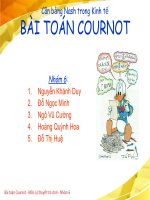slide môn lý thuyết dịch THE PROCESS OF TRANSLATION
Bạn đang xem bản rút gọn của tài liệu. Xem và tải ngay bản đầy đủ của tài liệu tại đây (716.25 KB, 26 trang )
Unit 2: THE PROCESS OF
TRANSLATION
Core readings
Bell, T. R. (1984). Translation and
Translating: Theory and Practice. London
and New York: Longman. (pp. 12-21)
Larson, M.L. (1998). Meaning-based
Translation: A Guide to Cross-Language
Equivalence. University Press of America.
(pp. 3-12)
Newmark, P. (1988). A Textbook of
Translation. Prentice Hall. (pp. 11-30)
2
Contents
Larson’s
Bell’s
model (1984)
model (1991)
Newmark’s
model (1995)
3
Larson’s model (p.4 )
Bell’s model (p.21)
Newmark’s translation
process
Text
analysis (before
translating)
The process of translating
I. Text analysis
4 main steps:
Read the ST to understand its content
and the author’s point of view
=> General and close reading
Determine the ST’s intention
Choose an appropriate translation
method
Identify possible/ potential problems
I. Text analysis
Contributing factors:
1. Text intention
2. Text types
3. Readership
4. Stylistic scales
5. Setting of the text
6. Quality of the ST
7. Cultural aspects
1. Text intention
Intention of the text : the author’s
attitude to the subject matter
Intention of the translator
◦ In general: identical with that of the author
◦ Exception: shortening and/ or over-translation
for particular target readership
2. Text types
◦ Narrative
◦ Description
◦ Discussion
◦ Dialogue
3. Readership
3 types:
◦ Expert
◦ Educated layman
◦ The uninformed
=> Distinctive in terms of level of
education, social class, age and
gender
4. Stylistic scales
◦ Formality
◦ Generality and difficulty
◦ Emotional tone
4. Stylistic scales
Formality
◦
◦
◦
◦
◦
◦
◦
◦
Officialese
Official
Formal
Neutral
Informal
Colloquial
Slang
Taboo
4. Stylistic scales
Generality or difficulty
◦
◦
◦
◦
◦
◦
Simple
Popular
Neutral
Educated
Technical
Opaquely technical
4. Stylistic scales
Emotional tone
◦
◦
◦
◦
Intense (hot)
Warm
Factual (cool)
Understatement (cold)
=> Attitude of the author
◦ Negative
◦ Neutral
◦ Positive
5. Setting of the text
◦ Where would the target text be
published?
◦ Addition/ omission of titles/ subtitles/
subheadings, etc.?
◦ Is the TL readership identical with
the SL readership?
6. Quality of the ST
◦ Well or poorly written?
◦ What modification is needed?
7. Quality of the ST
◦ Neologisms
◦ Metaphors
◦ Cultural words
◦ Proper names
◦ Technical terms
◦ “Untranslatable words”
II. Translating process
4 levels “more or less consciously in mind” (p.
22-30)
◦ Textual level: literal translation
◦ Referential level: visualize the text
◦ Cohesive level: structure, smooth and emotional
tone of the text
◦ Natural level: the translation makes sense and it
reads naturally
Keep in parallel the 4 levels
Discussion
Which approach do you prefer when you
translate?
Approach 1:
◦ Read through the ST
◦ Quickly produce the draft translation
◦ Spend much time revising the draft translation
to have the final version
Discussion (cont.)
Approach 2:
◦ Carefully read the ST
◦ Produce the draft translation, make reference
if necessary
◦ Revise the draft translation until you are
satisfied with it
Which approach do you actually follow?
(a) Students are arranged by class
number and do not move from
classroom to classroom between classes.
They also stay together as a small
group for their entire elementary,
junior-high, or high-school levels in one
location.
“do not” = ‘không thể’ OR ‘không phải’
The draft proposal suggests that Vietnam would be
able to build a university that is internationally
competitive within 10 years. This is exactly the sort
of over-optimistic and unachievable time target that
was announced when the National Universities in
Ha Noi and Ho Chi Minh City were first set up by
merging various local universities. This historical
lesson must be learnt and what is important now is
to articulate a time frame that is consistent with
the fact that no Vietnamese university is seriously
ranked within ASEAN, let alone East Asia.
Satisfying the local demand for electricity from
wind is not the end of the story. Cheap
electricity produced from wind can be used to
electrolyse water, producing hydrogen, now
widely viewed as the fuel of the future. With
automobiles powered by fuel cell engines ex
pected on the market within a few years and
with hydrogen as the fuel of choice for these
new engines, a huge new market is opening up.
The cause of autism has
also been a matter of
dispute. Though Asperger
regarded it as a biological
defect of affective contact
—innate,
inborn,
analogous to a physical or
intellectual
defect—
Kanner tended to view it
as a psychogenic disorder,
a
reflection
of
bad
parenting,
and
most
especially of a chillingly
remote,
often
professional, "refrigerator
mother."
Researchers have had a
hard time agreeing on the
causes of autism. On the
one hand, Asperger saw
the
condition
as
representing
a
constitutional defect in
the child's ability to make
meaningful
emotional
contact with the external
world. On the other hand,
Kanner regarded autism as
a consequence of harmful
childrearing practices. For
many
years
confusion
about this condition reigned.









